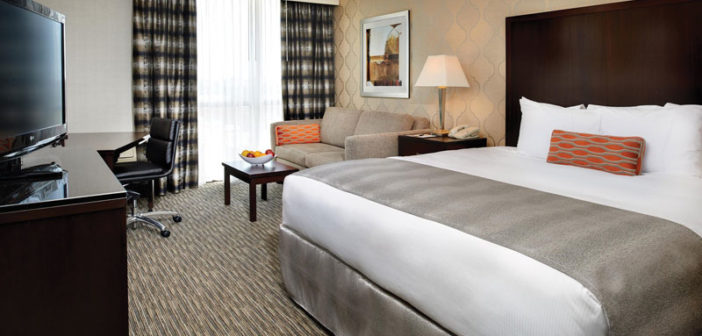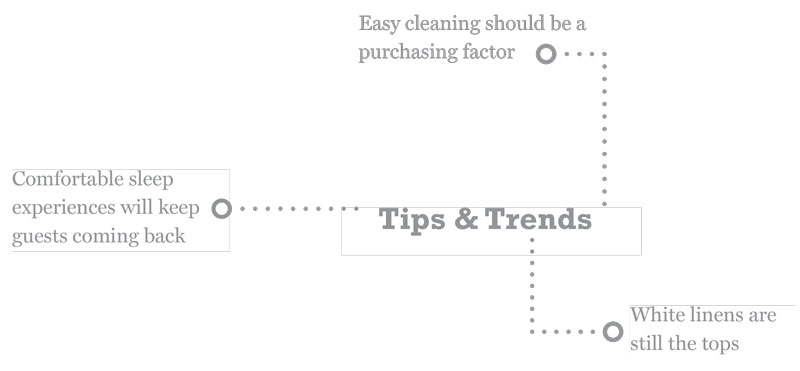 For most travelers, the most important aspect of their stay is the guestroom—and the most important part of the guestroom is the bed. A good night’s sleep can set the tone for the entire next day.
For most travelers, the most important aspect of their stay is the guestroom—and the most important part of the guestroom is the bed. A good night’s sleep can set the tone for the entire next day.
“The bed and overall sleeping experience is incredibly important from a guest perspective; it’s the essential reason why they book a hotel room,” said Ben Nicholas, principal at The Gettys Group. “Guests have come to expect and cherish the crisp, clean sheets and perfectly piled pillows—an oasis from the chaos of the day to day. As the largest piece of furniture in the room, the guest forms a first impression largely based upon the look of the bed, setting the tone for their overall experience.”
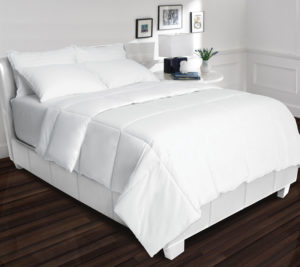
The Beautyrest Sleep Collection from Simmons Hospitality Bedding and Hollander Sleep Products is a tiered offering, which includes pillows, mattress toppers, pads and protectors in a variety of sizes, fabric and fill options.
Aaron Smith, regional VP of operations with Baywood Hotels, agreed. “Over the years, it seems hotels went away from the core reason our guests stay: a clean comfortable bed,” he said. “In recent history, the focus really has come back to the bed experience, from sheet design, to bed quality, to pillow selection, to packaging the bed together as a focal point—it’s all part of the guest having an overall positive stay experience. If you cannot give guests a great night’s sleep, the chance for a repeat stay is hard to achieve.”
Kristie Dickinson, EVP, CHMWarnick, a hotel asset management and owner advisory services company, added, “The bed is probably the single most important element of the guestroom and key to overall experience—and, while the rest of the experience (service, ancillary operations, etc.) needs to be there too, an old or uncomfortable bed can make or break a stay even if everything else is perfect.”
At IHG, the guest’s sleep experience is extremely important. “Sleep is core to our business and we have a vision—to create the most comfortable, carefully designed and holistic sleep experience in the hospitality industry,” said Errol Williams, VP, Americas brand operations with the company. “We want to be known by guests as the place that values and sets the industry standard for a great night’s sleep.”
A restful experience often comes down to one thing: the mattress. Extensive research goes into choosing the right one for a property. For example, IHG conducts testing when choosing its mattresses. “Mattress comfort rating has the greatest impact on our guests’ sleep experience,” said Williams. “We have, and continue to conduct, rigorous consumer testing—sometimes longer than 12 months—to identify the top performing mattresses and bedding for our guests.”
Of course, protecting the mattress is important for hotels to do as well. Mattress and pillow covers are a way to limit the chance for bed bug infestation, as these places can be an ideal hiding spot for the little creatures.
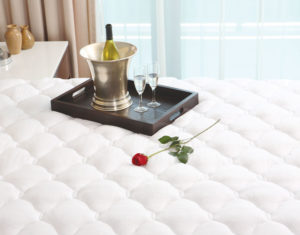
The CKI Solutions Dream Line Topper provides a 3-in. loft to any mattress. The loft does not move or flatten the way that down does because of the way it is designed, according to the company.
“We require mattress protectors to help obviously with the longevity of the mattress from stains, rips, etc.,” said Baywood’s Smith. “We have tested out the full encasements in our properties to avoid possible bug infestations.”
“IHG requires mattress protectors or pads for our mattresses, and our approved mattresses and protectors also use antimicrobial and water-resistant fabrics,” said Williams.
When it comes to the bed itself, Lauren Christel, director of design at Sparks Glencoe, MD-based interior design firm Studio Partnership, has seen a move away from metal bed frames to box-spring covers coordinated with the rest of the interior. “Bed skirts are difficult to maintain and usually end up looking shabby, or they sag after time,” she said. “The box-spring cover eliminates this issue, giving the bed a more polished look.”
For Gettys’ Nicholas, the bed and its coverings are another element to allow for a space to feel more personalized. “Bringing guestrooms to life with punches of color and local flair makes the experience feel more personalized,” he said. “This has historically been executed through art and accessories, but can be achieved through the bed, as well.”
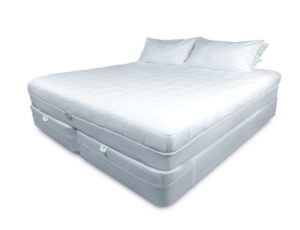
CleanBrands’ CleanRest Platinum Dream Defender is the first three-in-one utility bedding product designed to replace the quilted pad, waterproof protector and encasement, while meeting or exceeding all brand standards, according to the company.
At the DoubleTree by Hilton Chicago Magnificent Mile, the interior design team at The Gettys Group created an artistic headboard that became a statement piece, deeply rooted in the design narrative for the hotel as a whole. “The city grid of Chicago was abstracted in multiple colors of faux leather to create an urban feel,” Nicholas said. “To balance this feature, a bright accent pillow was added—referencing both the geometry of the downtown streets and the cultural flair of the Windy City.”
For Studio Partnership’s Christel, who calls the hotel bed the focal point of the room, details matter. “Take the headboard, for example. Whether it’s floor to ceiling and upholstered in an embossed leather, has nailhead trim or incorporates custom artwork, the headboard is an opportunity to make a big impact on the design of the room,” she said.
When it comes to linens, white is still the go-to color. “Regardless of the hotel’s individual aesthetic, white continues to reign supreme,” said Nicholas. “In projects ranging from a celestially inspired Art Deco property in Columbus, OH—Hotel LeVeque—to a refined, yet charming Amherst, NY hotel steeped in local history—Reikart House—our interior design team turned to bright whites to communicate a sense of cleanliness, calm and comfort.”
White linens imply cleanliness. “In terms of color, guests still prefer white linens since they provide a quick assurance of cleanliness,” said IHG’s Williams. “One thing you will notice are more styles featuring white-on-white with subtle patterns engrained within to add that extra pop of texture and luxury.”
While the sheets may be white, other top-of-bed items can add color. “When used, the decorative throw pillow is usually the pop of color, or accent,” said Christel. “It often ties in with the artwork, which plays a big role in the overall design of the room. We typically design warm, neutral rooms for a classic and timeless look, but we introduce color, texture and pattern in art or accent materials and pillows—these pieces give the space its personality and allows the hotel operator more flexibility to easily swap out smaller, more trendy items while leaving the more costly ones for when a major renovation is necessary.”
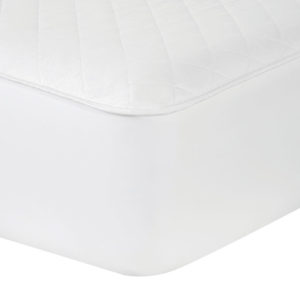
The Waterproof Quilted Mattress Pad from Protect-A-Bed not only enhances comfort by adding a cushioned layer to mattresses, but increases the lifespan and health of mattresses by providing a layer of air-vapor-porous protection that prevents allergens, pests and stains, according to the company.
While polyester is still the leading material, others are gaining traction. “Technology has allowed for the creation of durable, breathable, often eco-friendly materials to be used,” said Christel. “A designer is no longer limited to the stiff, scratchy fabrics from 20 years ago. Nowadays, most manufacturers offer a range of hard-wearing, beautiful fabrics that look and feel like they could be used in a high-end residential home.”
That feel is important to Nicholas as well. “The guest expects cleanliness, but they are delighted by the feel of the product,” he said, adding that owners and operators should “look for products that will last for the property, but that also have been manufactured to be appealing to the guest.
“Polyester still reigns,” he continued. “However, we have an increasing number of operators that are looking at bamboo, cotton, viscose or repurposed fiber materials for their bed linens.”
When purchasing bedding, Williams said it is important not to cut corners. “Sleep is one of the most critical areas for our guests’ health and well-being,” he said. “When someone arrives from a long trip or after a long day, the sleep experience is so important to their ability to recharge and be their best the next day. Purchase the right products, care for them properly, and replace them immediately when needed.”
Along with buying the right products, he said it is “critical to have a very strong cleaning and maintenance program. Work closely with your hotel team and corporate partner (quality consultant, etc.) to understand the best ways to care for new mattresses, pillows, linens, etc. Checking condition regularly, and washing and drying the right way will really help you get the most out of your investment.”
Nicholas echoed this advice. “Bed linens in general always needed to be commercially cleanable,” he said. “These days, even the eco-friendly materials we specify can be compliant with commercial washing machines and dryers.”
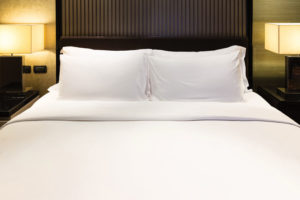
SilkyWay Sheets by Venus are designed to be soft and long lasting. The micro-fiber sheeting was developed for the hospitality industry.
“Everything must be washable—that goes for decorative throw pillows as well,” added Christel. “While many hotel operators are opting not to add the decorative pillow, when they do it must be made from durable, washable materials and with a removable cover.”
While having a comfortable bed with fresh linens is important, CHMWarnick’s Dickinson cautioned that hotels shouldn’t purchase new bedding just for the sake of it. “From an owner’s perspective, an investment in a property should reinforce its competitive positioning and yield a return, so we do not typically advocate replacement of anything to solely add a ‘fresh look’ or comply with new brand standards that come up out of the planned replacement cycle,” she said. “Rather, we look to do so at the appropriate time in accordance with the strategic capital plan that has been established. Replacement of guestroom soft/hard goods out of sync with the plan can have a material impact on reserves and future spending, and the decision to do so would have to be very compelling from a guest, competitive and business impact standpoint.
“Most ownership groups work through brand procurement, but these practices should always be reviewed and on occasion challenged to ensure you’re getting the best quality and the best price given the owner’s capital that funds these purchases,” she continued. “I do think there have been instances where the bed has been a wise marketing move in the past and has helped shape and become hallmarks of certain brands (e.g., Westin). Today, however, I’m not sure how much this is factoring into guest decision about where to stay, and from an ownership standpoint, guests have not demonstrated a willingness to pay more—a good bed is simply an expectation.”
Protect your purchases against bed bug infestations
Owners and operators put a lot of care into all of their purchases—including bedding—in order to give their guests the perfect experience. But one way to ruin that experience is the scourge of bed bugs. While hotels can—and should—purchase products to help protect their investments and their guests against an infestation, there are ways that hotels can minimize their risk of a pest problem.
According to William D. Frye, program coordinator at Niagara University’s College of Hospitality and Tourism Management in New York, bed bugs were thought to be mostly eradicated in the United States after World War II, but have staged a resurgence since the late 1990s.
They can happen in any type of hotel. “People often have the misconception that only dirty hotels are susceptible to bed bugs,” he said. “However, bed bugs can show up anywhere from economy and limited-service properties to five-star hotels. Hotels located in gateway cities and large urban locales are most at risk, especially those in high humidity climates.”
Unfortunately, despite best efforts, bed bug infestations cannot be prevented from occurring in a space. “Therefore, we must constantly be vigilant for their presence and then take appropriate steps to prevent their spread and remove them from the premises,” said Frye.
There are some housekeeping and maintenance practices that will help reduce the opportunities for the bed bugs to thrive in a hotel. “Room attendants can practice good housekeeping that reduces the opportunity for bed bugs to spread,” he said. “Vacuum rooms regularly and carefully. Vacuuming can be very useful for removing bugs and eggs from mattresses, carpet, walls and other surfaces. Pay particular attention to seams, tufts and edges of mattresses and box springs. Take the time to vacuum the perimeter edge of wall-to-wall carpets. Afterward, dispose of the vacuum contents in a sealed trash bag.”
Diligent maintenance procedures can also help to prevent the spread of bed bugs. “Cracks and crevices should be caulked,” said Frye. “This includes the space between the headboard of beds and the wall. Also, pay particular attention to any small cracks near the baseboard of the wall and where the wall meets the floor. Loose wallpaper should be repaired immediately. Bed bugs are tiny, flat pests that can squeeze into the smallest crack or crevice, so no space is too small to caulk or seal.”
The housekeeping staff is the first line of defense against a bed bug infestation. Room attendants should inspect guestrooms by looking closely at the sheets and bedding. “The sheets used by guests may have small bloodstains on the pillowcases and sheets,” said Frye. “The bloodstains may look like small, reddish-brown spots. Check the mattress by closely inspecting the seams for brown spots that could be bug feces, shed skin or actual bed bugs. Also, check for brown spots in cracks and crevices using a flashlight to look for signs of infestation. Bed bugs can hide in the smallest spaces between headboards and walls. Check furniture seams, draperies, molding and areas where wallpaper may be loose. Also, check behind picture frames and baseboards, especially those located near beds, and thoroughly inspect any used furniture or fixtures for bed bug infestation before installing them into guestrooms.”
“We train all our staff to recognize signs of such and require the bed to be stripped down to the mattress to ensure checks for anything that would inhibit the next guest’s stay experience,” said Aaron Smith, regional VP of operations, Baywood Hotels.
“Hotel colleagues are trained to inspect mattresses daily as they change the sheets,” said Errol Williams, VP, Americas brand operations, IHG.
It is important to stop an infestation before it spreads, and to take signs of infestations seriously. Address guest complaints about bug bites immediately. “A person who has been bitten by bed bugs will likely have small reddish, bumpy spots on their body, in particular on their face and extremities,” he said. “Some people develop a hard bump with a whitish center that itches for days. Look into it and don’t ignore guest complaints.”
Once signs of an infestation are found in a guestroom, the room should be quarantined. “This includes all linens and even the floor vacuum cleaner that was used to clean the guestroom,” explained Frye. “A professional pest control company should be called to inspect and treat the infested room. The rooms adjacent to the infested rooms should also be inspected for signs of infestation.”
Linens should be washed and dried in very hot temperatures. “Tumbling dry bedspreads for 30 minutes at a 120-degree Fahrenheit temperature will kill bed bugs, and then wash them in hot water,” he advised. “Steam cleaning furniture, especially around the seams and crevices, will also kill these pests.”

